|
Monday, December 13, 2010
Progress Notes
A couple of months ago I discussed the Lumpkin family of Miller County whose Miller County patriarch was William Simpson Lumpkin, the educator who established the Miller County Institute at Spring Garden (photos 01 and 02).
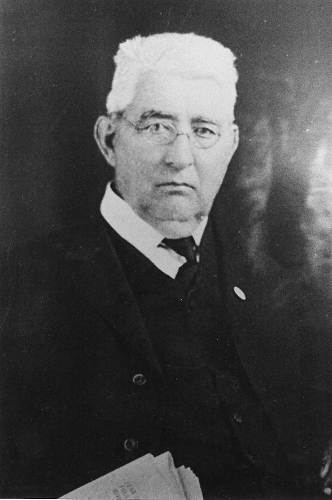
01 William Simpson Lumpkin 1832 - 1925
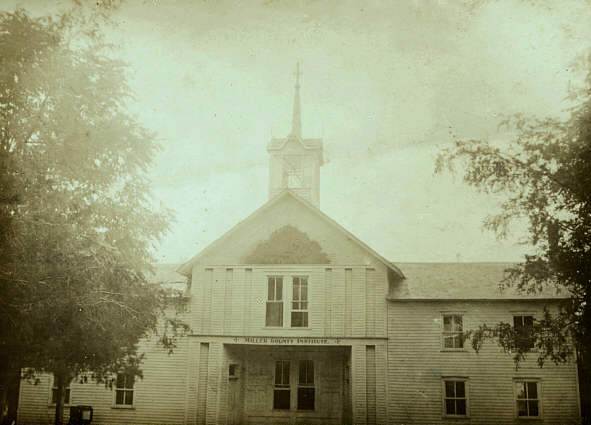
02 Miller County Institute This week I want to review the history of another well known educator of Miller County of the late 1800’s, Professor Herbert Leo Moles, who was director of the Miller County Institute after William Lumpkin (photo 03).
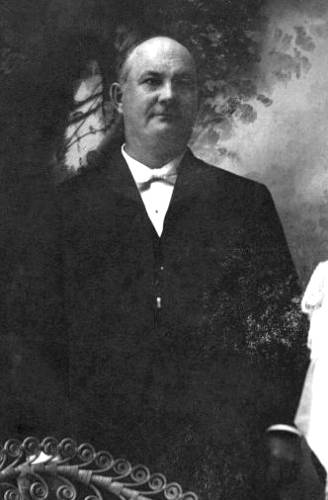
03 Professor Herbert Leo Moles Professor Moles not only was an educator but was somewhat of an entrepreneur having business interests in Tuscumbia as well as a large farm near Bagnell.
He was born in Patrick County of the state Virginia in 1857 but did not live there long because his parents, John and Susan Moles, moved to Clarksburg, Missouri a few years after his birth (photo 04).
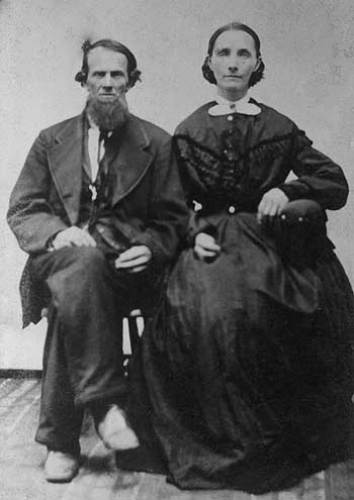
04 John and Susan Moles The Goodrich history of Miller County recounts the life of Professor Moles up to the year 1899 when the book was first published:
Professor H.L. Moles, principal of schools at Aurora Springs, was born in Patrick County, Virginia, in 1857, and is the second in a family of four children born to John B. and Susan (Corn) Moles, both natives of Virginia. The father was a farmer by occupation, but also followed the teacher’s profession. He immigrated to Missouri in 1858, settling near California, Moniteau County, and there improved a farm. He takes an active part in politics, votes with the Democratic party, and has been county assessor. He is still living, as is also his wife. Professor H.L. Moles was reared to the arduous duties of the farm, receiving his education in the district schools of Moniteau County and in the Normal School at Warrensburg, Missouri, where he attended nearly three years. He then took a commercial course in Northern Indiana, and also attended the Normal School at Valparaiso, Indiana, which he finished in 1881. He then returned to Warrensburg, Missouri, attended school a short time, and soon took charge of the school at Spring Garden, called the Spring Garden Seminary. While there the school was reorganized, and Professor Moles was instrumental in building up the same, which was afterward called Miller County Institute. After leaving Spring Garden Professor Moles came to Aurora Springs, where he engaged in teaching in the building known as “Cook’s Hall.” In 1885 was erected the two story brick building, of four rooms, making a commodious and substantial school building. The Board of Regents adopted a complete academic course, also law and commercial departments, and through the efforts of Professor Moles was organized the Miller County Academy, which has continued in a prosperous condition, until there is a large enrollment. Professor Moles has been engaged in teaching at this place more or less since that time. He is quite active in politics, and votes with the Democratic party; he was a candidate for school commissioner in 1883, and was a candidate for sheriff in the campaign of 1888. He is a member of the I.O.O.F. lodge at Aurora Springs, has held most every office, and has twice filled the position of Noble Grand. Professor Moles was married at Spring Garden in June, 1883, to Miss Olive Robinson, a native of Miller County, and the daughter of T.B. and Martha C. (Hawkins) Robinson. Mrs. Robinson is deceased, but the father is living, and is a resident of Tuscumbia. After marriage Professor Moles and wife settled in Spring Garden, but moved from there to Aurora Springs in 1884. He is a member of the Baptist Church, and Mrs. Moles a member of the Christian Church. To their union were born two children, Opal R. and Ethel S.
Note: After this history was written by the Goodrich authors, Professor Moles and his wife had additional children which will be detailed below.
The first mention of Professor Moles in our Miller County historical literature is the year 1879 when Professor Moles held the position of director at the Miller County Institute at Spring Garden. This information is found on our own website.
The paragraph below is copied from this website cited above:
In the year 1868, under the leadership of William M. Lumpkin, the community of Spring Garden built a two-story house and Mr. Lumpkin opened a private school called Miller County Academy. He continued to teach for several years and then Edward Henry and Julia Coleman of Springfield, Mo., taught for a year.
After this there was a period in which there was no school. In 1879, H.M. Sutton of Ada, Ohio, and H.L. Moles of Clarksburg, Mo. took charge and changed the name to Miller County Institute.
They continued teaching until Aurora Springs was built up, when H.L. Moles went to that town and H.M. Sutton carried on the school at Spring Garden with the help of W.A. Chalfant. Later he had associated with him, J. Roberts and wife.
The story of Professor Moles at Aurora Springs is best described in the Goodrich history of Miller County:
The Miller County Academy at Aurora Springs is an educational institution deserving prominent mention. On the bluff at Aurora Springs may be seen a large square two story brick structure with two rooms below and a large hall above, which was built after the town was founded, and at a cost of over $3000. Cook’s Hall, also an old store building, and a two story residence, had been used for the town schools, but were replaced by this structure, and among those most active in the matter were J.M. Williams, W.A. Miller, Colonel J.H. Stover, Professor W.M. Lumpkin, Drs. J.A. Stevens, Allen, Bills, Tremain, and several others. Common schools were held until 1884, when Professor H.L. Moles organized and graded the academy. Among the instructors who have been associated with him are Mrs. Moles, Miss Emma Shelton, Miss Carrie Torry, W.E. Allen, Professor Wagner (music), and Colonel J.H. Stover (law). The attendance has now reached seventy nine pupils, so that three rooms and occasionally four are used. Five courses are provided: Literary, scientific, law, music and commercial. The present attendance represents various parts of the county and some considerably beyond these limits. The present faculty embraces: Principal H.L. Moles, Mrs. H.L. Moles, M.L. Tremain, Colonel J.H. Stover and Miss B. Ballenger.
I don’t have a photo of the Aurora Springs Academy but the listing of teachers at the Aurora Springs School by Clyde Lee Jenkins which is found on our website includes Professor Moles:
Teachers: Judge Jenkins lists the following teachers for the early years of the school:
1882-83 John Dark & Mary L. Leach
1883-84 L. N. Musser
1884-85 H. L. Moles
1885-97
1898-99 George Carney
1899-00 Rella Jordan
1900-01 John J. Crocker
The photo included with this listing is of a small building (photo 05).
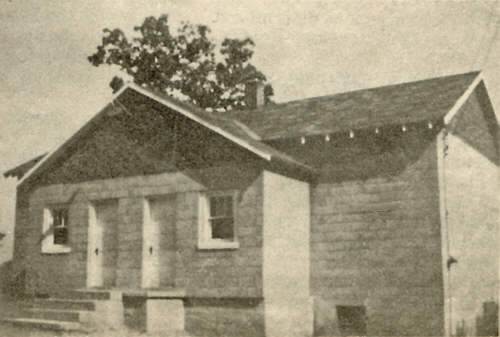
05 Aurora Springs School The building is not the two story brick building described above in the Goodrich history but may have been where the Aurora Springs Academy began since the year for the listing is 1884. That is the year Professor Moles began the academy in Aurora Springs.
1884 was an important year in the life of Professor Moles because while he was developing his school in Aurora Springs he also was courting Mary Olive Robinson, the daughter and only child of the respected Tuscumbia attorney, Theodore Robinson (photos 06 and 07).
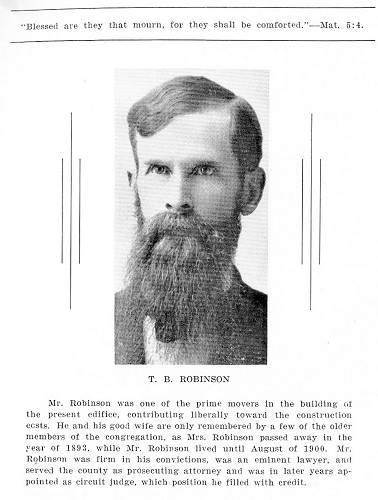
06 Theodore Robinson, taken from Tuscumbia Christian Church 50th Anniversary Book 1939
Click image for larger view
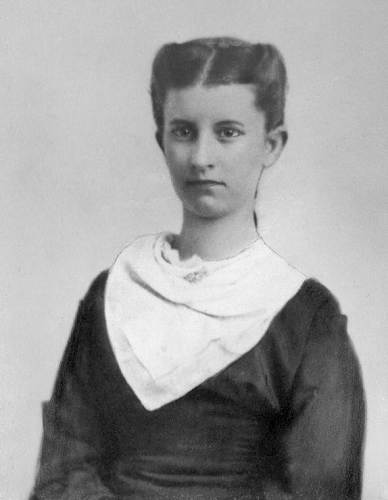
07 Mary Olive Robinson 1866-1900 - First wife of Professor Moles They were married in 1884 and had a total of eight children before Mary Olive died prematurely in 1900. However, this marriage brought to Professor Moles the inheritance of a large farm near Bagnell which in the 1905 plat map still was listed in Mary’s name. Here are copies from the plat map of the township and section closeup of the farm listed as belonging to “Mary O. Moles” (photos 08 and 09).
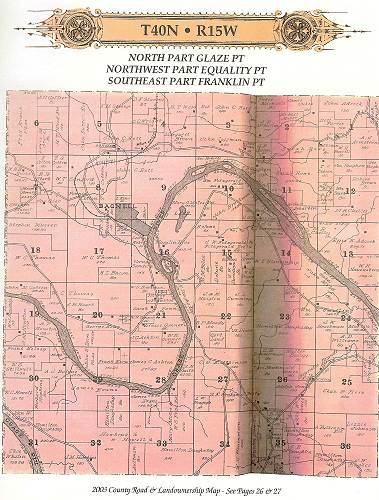
08 T40N - R15W
Click image for larger view
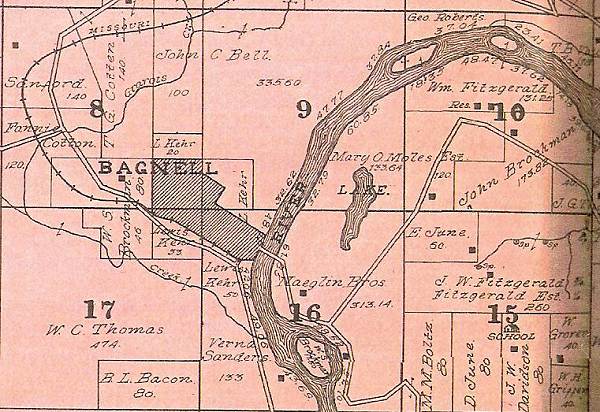
09 T40N - R15W - Sections 9 and 10 You can read more about Theodore Robinson at this previous Progress Notes.
Although Professor Moles was engaged in academic pursuits at the Miller County Academy in Aurora Springs, he found time to supervise the building of a home in Tuscumbia which according to the Tuscumbia Autogram was finished in July of 1891 (photo 10).
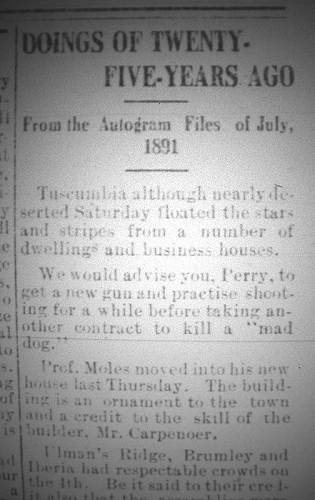
10 Professor Moles New Home
Click image for larger viewAccording to a history of homesteads on our own website, this home was built on the top of the hill above the Osage River on the Courthouse street along with a number of other homes listed. The information is found in the “Homestead Section” which discusses the neighbors of riverboat captain John Adcock whose home was next to the school:
“While they lived the few years in the village of Tuscumbia (The Adcocks) their near neighbors "on the hill" were William Perry and Alice Freeman (he was circuit clerk and recorder of Miller County); Warren Mary Barr; George P. & Martha Swanson (he was postmaster and owner of a hardware store); Herbert L. & Mary Olive Moles (a teacher and storekeeper); Theodore B. Robinson (attorney); and Mord & Lillian McBride (owner and publisher of the "Autogram" newspaper).
You can read more about Miller County homesteads at this webpage on our site.
You probably noticed in the list above that one of the Moles’ neighbors was Theodore Robinson, father of Mary Robinson, wife of Professor Moles.
Another attraction for living in Tuscumbia was that Professor Moles had gone into a mercantile business owned by his father in law, Theodore Robinson, as described in the paragraph below taken from this website.
“Between the years 1890 and 1933 there were many changes in the business roster of Tuscumbia. Among those engaged in the mercantile business here during the years referred to were found H.L. Moles and J.L. Cummings of the T.B. Robinson Mercantile Co., Walter M. and Frank W. Haynes of the Haynes Mercantile Co., A. Reed and Z.S. Livingston, J.L. Blackburn, F.W. Fendorf, F.E. Fendorf, H.L. Wright, W.S. Spearman, J.Z. Spearman, Geo. W. Helton, L.E. Crane, A.M. Schwabe, Charles Wyrick, Lafe Abbett, Jack Thompson, Asa Grady, W.S. Goodrich, J.N. Brockman, and J.A. Roark. G.P. Swanson conducted a hardware store and was at the same time postmaster. Some of those who were engaged in the grocery and café business were Sam Johnson, B.F. Lawson, B.W. Burris, Chas. Messersmith, Oscar Abbett, P.P. Wright, Jos. Shikles, Chas. Moore, A.F. Waddell, and John H. Potts.”
I asked Bamber Wright, whose uncle, William H. (Billie) Hauenstein III had married Ethel Moles, daughter of Herbert and Mary Moles, just which house was the one built by Professor Moles on the courthouse street. He told me it was the one in which Leonard Kallenbach lived, located across the street from Leonard’s grocery store. So I compared a photo I had of Leonard’s home and the home of the Moles’ and the porch and front facade appear very similar (photos 11 and 12).
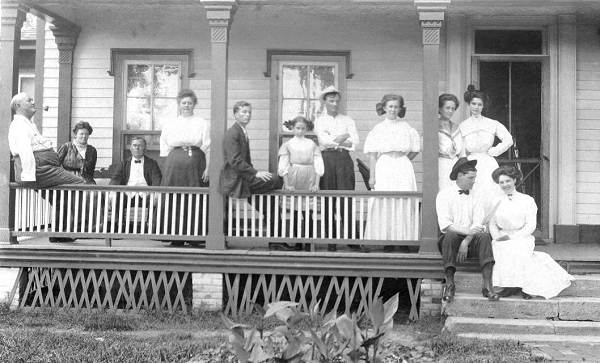
11 Moles Family on Porch - Later was Leonard Kallenbach Home
Click image for larger viewThe caption for the people on the porch in photo 11 is:
“Family gathering at the Herbert L. Moles home in Tuscumbia, Missouri. Herbert is at the far left. Lois Dean Moles is the little girl in the middle. Ethel Moles is on the right side leaning against the column, with her future husband, William H. Hauenstein III on the step in front of her. Approx 1910.”
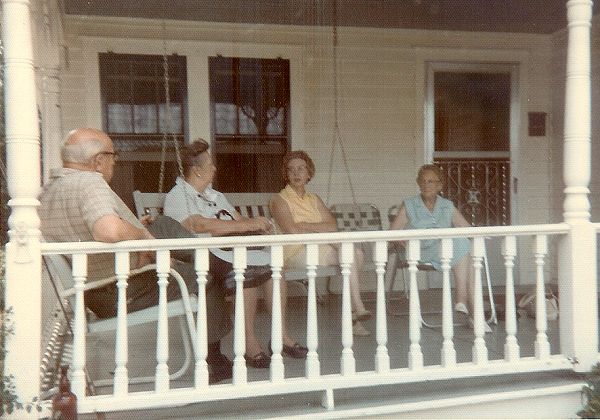
12 Leonard, Hattie, Geraldene and Hortense However, if you look closely at the two homes you will notice that the distance between the two windows is different in photos 11 and 12. Apparently, the original Moles’ home burned but was rebuilt. I discovered that the original home burned from an entry from the diary of C.B. Wright:
“December 30, 1916
H.L. Moles residence burned this morning at 2 a.m. Household goods in two front rooms were about all that was saved. All else is a complete loss.”
Finally, regarding reasons for Professor Moles to live in Tuscumbia, I found an old article in the October 3, 1889 edition of the Miller County Autogram which states “Prof. Moles now in charge of the public schools at Tuscumbia” (bottom of page - photo 12a).
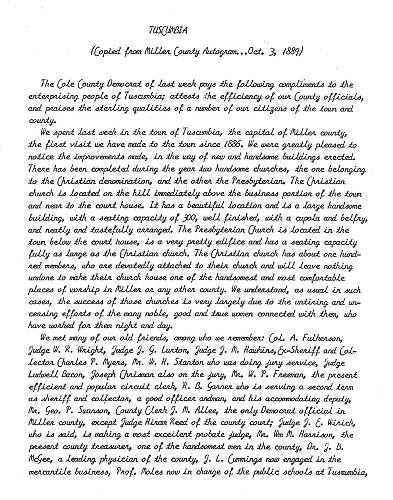
12a Article from Cole County Democrat published in Tuscumbia Autogram
Click image for larger viewSo, in addition to his supervision of the Miller County Academy at Aurora Springs, apparently he also was supervising the Tuscumbia school as well!
The children of Herbert and Mary Robinson Moles were:
i. OPAL ROBINSON MOLES, b. Feb 6, 1886, Aurora Springs, Miller Co, Missouri; d. Oct 4, 1889, Tuscumbia, Miller Co, Missouri.
ii. ETHEL SUSAN MOLES, b. Oct 5, 1888, Aurora Springs, Miller County, Missouri; d. November 18, 1969, Jefferson City, Missouri.
iii. RUBY IRIS MOLES, b. Mar 5, 1891, Aurora Springs, Miller Co, MO; d. 1984, Tuscumbia, Miller Co, MO; m. ROSCOE L. BROWN, Apr 28, 1912, Miller County, Missouri; b. 1886; d. 1966, Tuscumbia, Miller County, Missouri..
iv. JOHN ROBINSON MOLES, b. August 16, 1892, Aurora Springs, Miller County, Missouri; d. February 27, 1905, Miller County, Missouri.
v. TOM HAZEL MOLES, b. May 24, 1894, Aurora Springs, Miller County, Missouri; d. Aft. 1969.
vi. MARY OLIVE MOLES, b. June 24, 1898, Miller County, Missouri; d. Aft. 1969; m. FRED J. PIKE, October 27, 1922; d. August 06, 1963.
vii HERBERT LEO MOLES, JR., b. November 24, 1899, Miller County, Missouri; d. July 03, 1900, Miller County, Missouri.
Herbert Moles’ first wife, Mary Robinson Moles died prematurely in 1900. Professor Moles then had a second marriage to Olive Crisp in 1902 (photo 13).
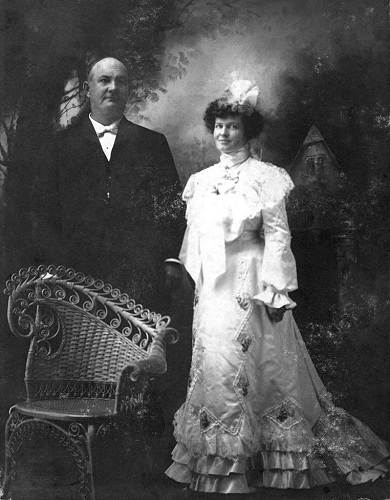
13 Herbert L. Moles and 2nd wife Olive Crisp - Wedding Photo - 1902 Their children were:
viii. LOIS DEAN MOLES, d. Aft. 1969; m. UNKNOWN SMEAD.
ix. ALMA JEWEL MOLES, b. January 01, 1903, Miller County, Missouri; d. January 06, 1903, Miller County, Missouri.
Information from the Social Security Death Index reveals the following about Lois and her husband Herbert:
SMEAD, LOIS D. : b. 05 OCT 1910 - d. 15 MAR 2000
Last Residence: Wickenburg, Maricopa County, Arizona
SSN: 552-20-2689 Issued: California
SMEAD, HERBERT : b. 19 Jun 1909 - d. 06 Feb 1999
Last Residence: Wickenburg, Maricopa County, Arizona
SSN: 107-03-9358 Issued New York
Here is a photo of Olive Crisp, the second wife of Professor Moles, with their daughter, Lois Dean (photo 14).
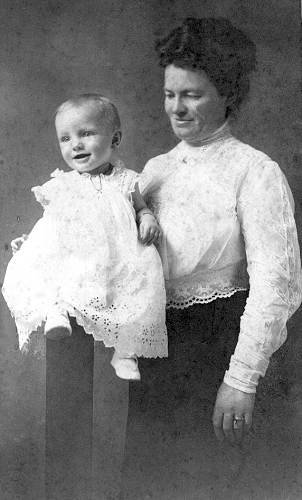
14 Lois Dean Moles and her mother, Olive Crisp Moles, 2nd wife of Herbert L. Moles - 1906 Their other child, Alma Jewel died soon after birth as noted above.
Of all of the events for which Professor Moles may be remembered in Miller County, his career as an educator may rank second to the fabulous wedding he and Mrs. Moles held for their daughter, Mary Olive Moles, to Jean Richard Popejoy of California, Missouri. The article in the Autogram published August 31, 1916, records an event probably not equaled before or since in the county seat of Miller County. The ceremony, which was held in their home located across the street from the courthouse, included band music, flower displays of extraordinary design and beauty, and a guest list that included the most important people of Miller and several surrounding counties. The list of gifts given to the couple included many expensive items of silver and china. I copied the article from that old Autogram edition and have it attached here for those who are interested. After reading it, I came away with the impression that Professor Moles must have been considered a very important figure in the county at the time based on the people who attended and the gifts they gave. You can read the article at this attachment (photo 15).
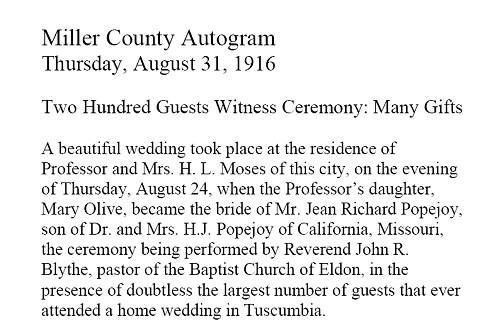
15 Moles Wedding Ceremony Article
Click image to read entire article in PDF formatHerbert Moles suffered an untimely death from an unlikely cause; In 1918 he developed an infection from an injured toe and died of gangrene at the age of 61. Of course, no antibiotics were available then. His physician was Dr. Kouns. Here is a copy of the death certificate of Professor Herbert Leo Moles (photo 16):
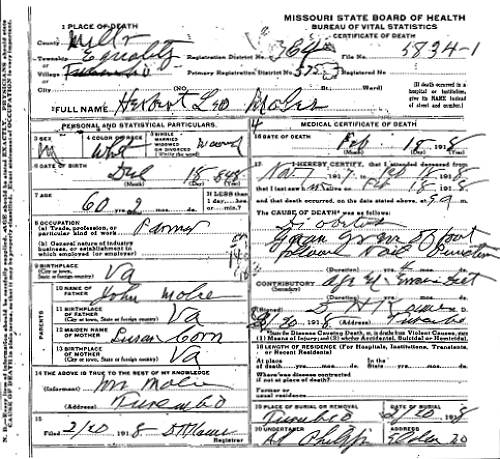
16 Death Certificate of Herbert Leo Moles And here is the entry from C.B. Wright’s diary about Professor Moles’ death:
“February 18, 1918
H.L. Moles died here today…took to his bed last November on account of sore foot caused by tack in his shoe.”
One of the children of Professor Moles best known around Tuscumbia was Ethel. She was a best friend of several of the young Tuscumbia ladies at the time. Here she is in a photo with her sister Ruby and three other Tuscumbia young ladies named in the photo (photo 17).
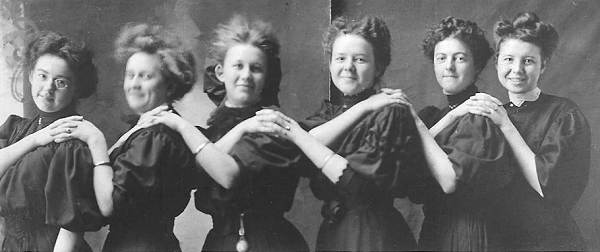
17 Clara Kouns, Ethel Moles, Ruby Moles, Lizzie Hauenstein, Mary Kouns and Lela Hauenstein Ethel attended William Woods College in Fulton at the same time as another Tuscumbia native and friend of Ethel, Elizabeth Hauenstein Wright, mother of Bamber Wright (photo 18).
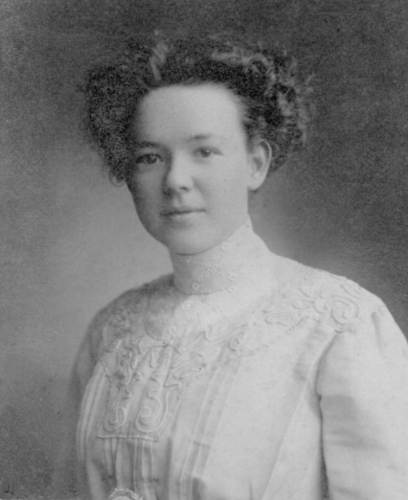
18 Elizabeth Hauenstein Elizabeth was the daughter of William H. Hauenstein II, the steamboat captain and one of the owners of the Anchor Mill (photo 19).
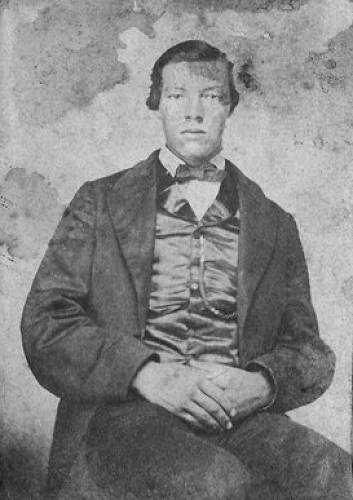
19 Captain William H. Hauenstein II Ethel enjoyed her years at William Woods College as one can discern by looking at several photos of her and her friends at the college (photos 20 - 24).
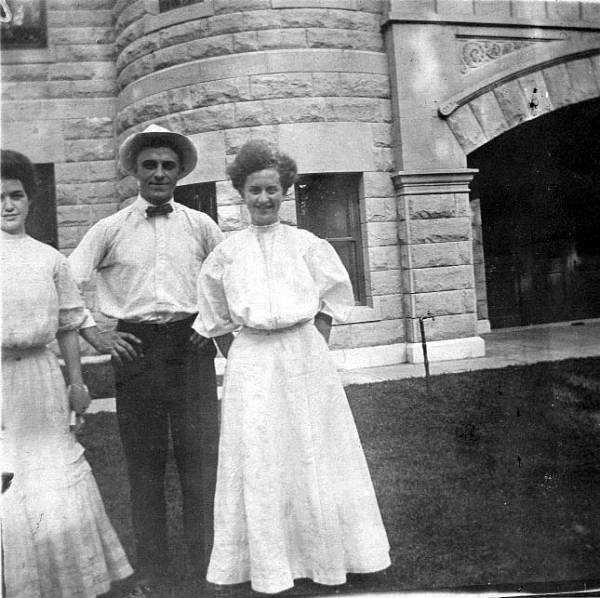
20 Ethel Moles at School
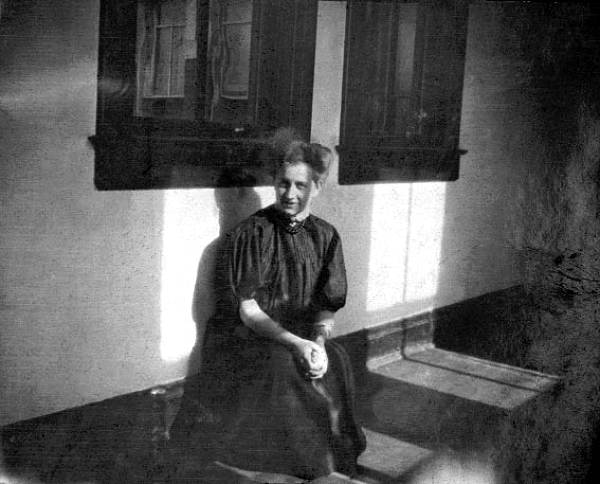
21 Ethel Moles at School
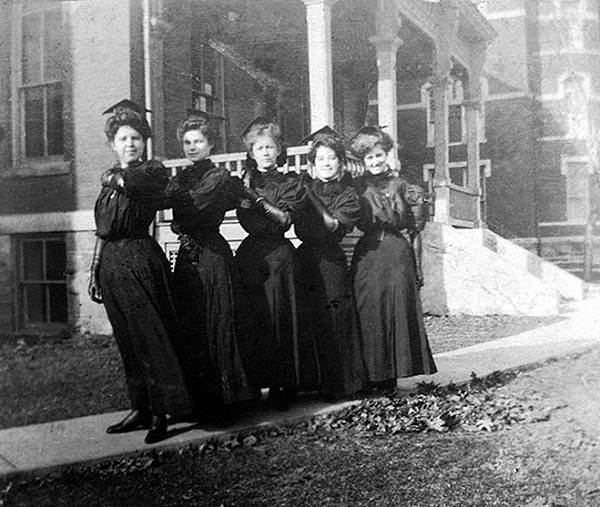
22 Ethel Moles at School
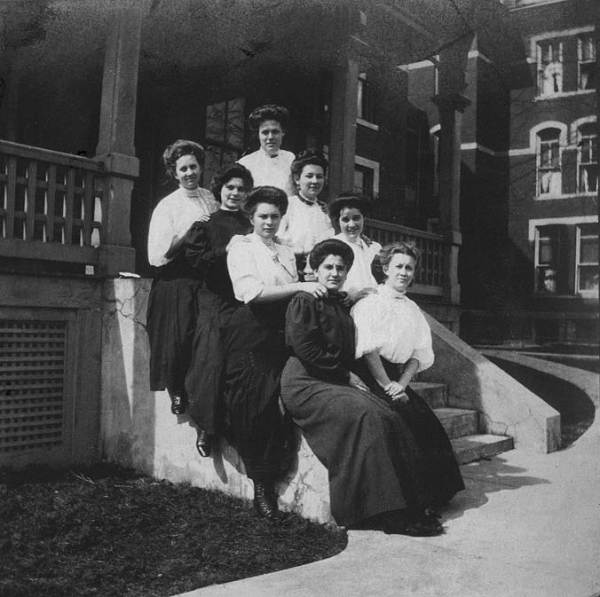
23 Ethel Moles at School
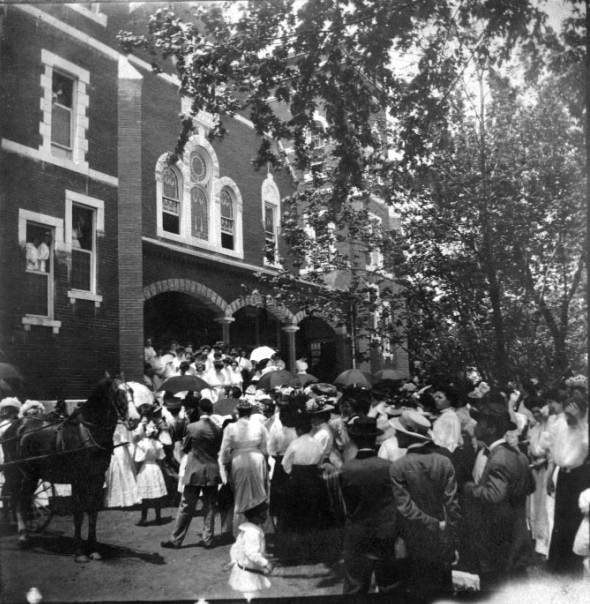
23 Ethel Moles at School Ethel became good friends with William H. “Billie” Hauenstein III, the brother of her friend, Elizabeth Hauenstein (photo 25 - 28).
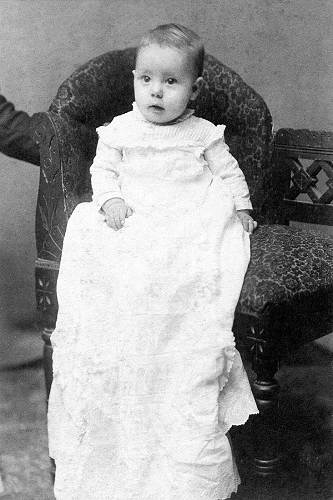
25 William H. Hauenstein III - Baby
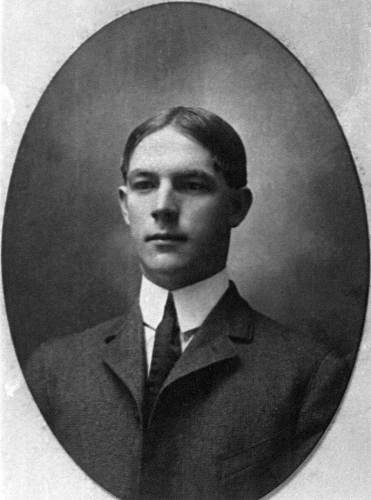
26 William H. Hauenstein III - Young Man
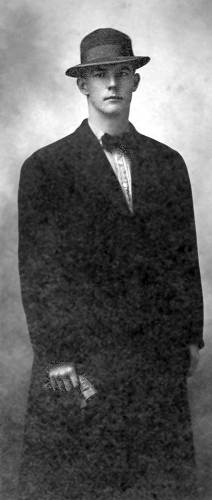
27 William H. Hauenstein III - In Hat
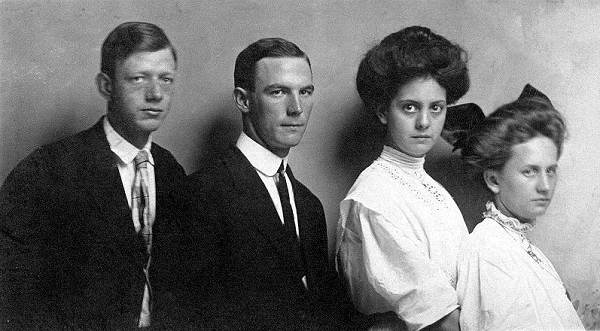
28 William H. Hauenstein III (2nd from Left) and Ethel Moles Hauenstein (Far Right ) Because three of the Hauenstein men had the same name, Tuscumbians distinguished them by referring to the old patriarch William I as William (photo 29), his son William II as Captain Hauenstein (see photo 19 above and photo 30), and his grandson William III as “Billie.”
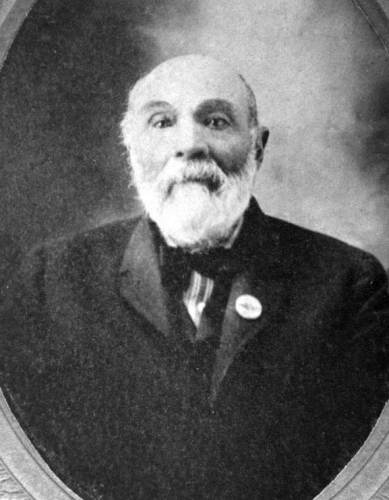
29 William H. Hauenstein
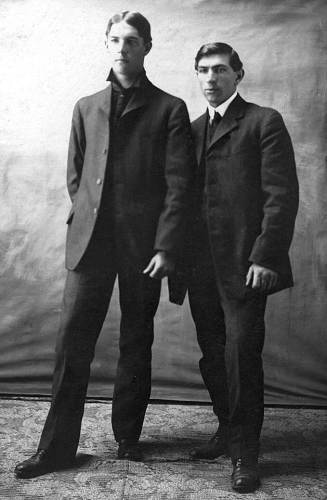
30 William H. Hauenstein II and Friend William Hauenstein II had a fine Osage River bottom farm about five miles west of Tuscumbia on what is now known as Brockman Spring road. His son “Billie” loved to work around the farm. Billie especially enjoyed his horses (photo 31).
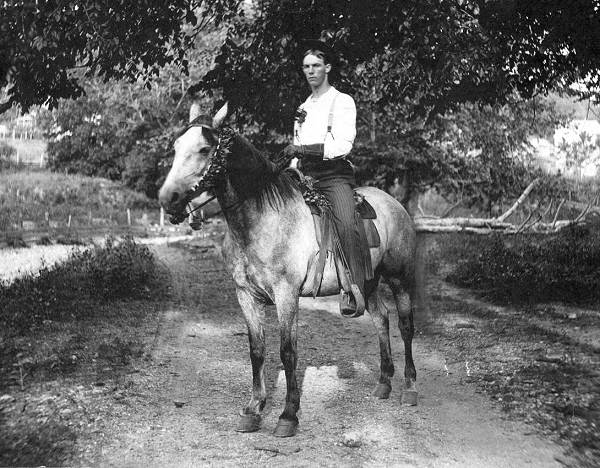
31 W. H. Hauenstein III on Horse However, the William Hauenstein II family didn’t live on the farm but lived in one of Tuscumbia’s finest homes located at the end of Goosebottom Street (photo 32).
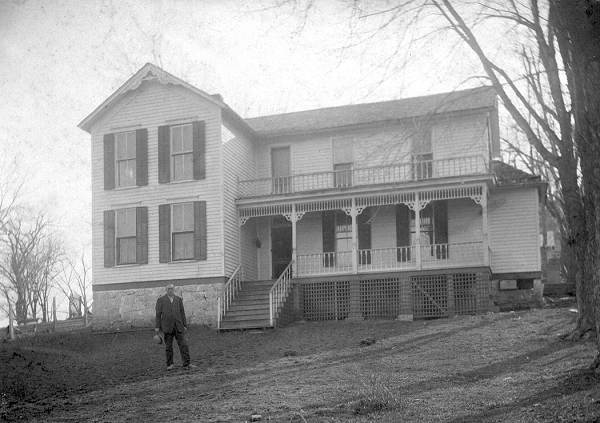
32 W. H. Hauenstein II and New House This is where Billie and Elizabeth were raised (as well as Bamber Wright (photo 33), son of Elizabeth and Homer Lee Wright, who also lived there after they married).
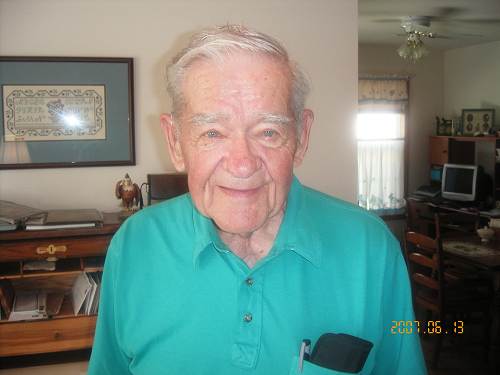
33 Bamber Wright - June 13, 2007 It would not be surprising to learn that two of Tuscumbia’s finest young citizens would begin courting and finally marrying which is what occurred with “Billie” Hauenstein and Ethel Moles (photo 34); nor that having the good fortune to be born into families of some means, they could take their honey moon in far away St. Louis (photo 35).
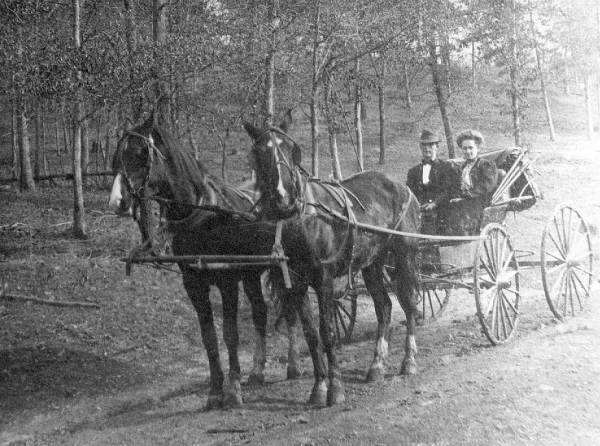
34 William H. Hauenstein III and Ethel Moles before Marriage - 1910
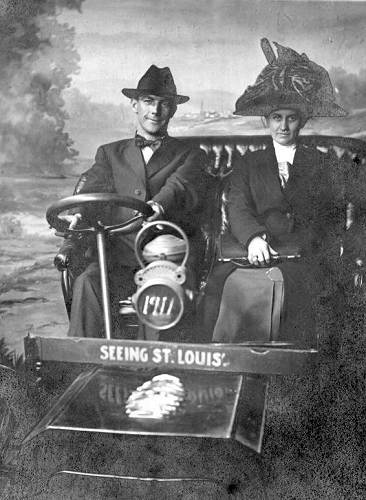
35 William and Ethel Moles Hauenstein III
Honeymoon in St. Louis - 1911 After marriage “Billie” and Ethel moved into a very comfortable home on the farm Billie so loved up the river road (photo 36).
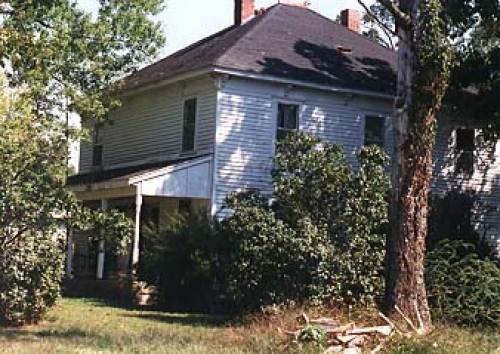
36 William H. Hauenstein III Home on Osage River Farm near Tuscumbia This home was well constructed and has been maintained through the years. Here are two recent photos of it (photos 37 and 38):
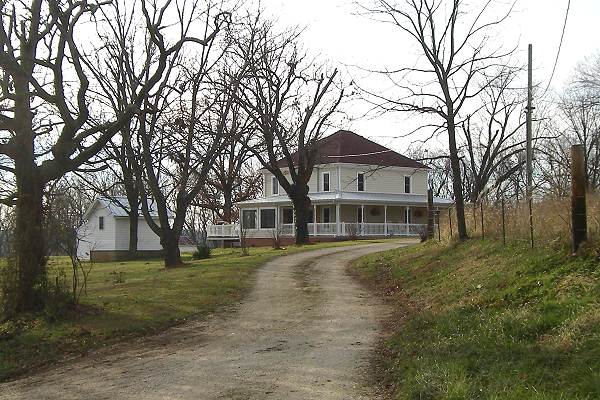
37 Hauenstein Home - 2010
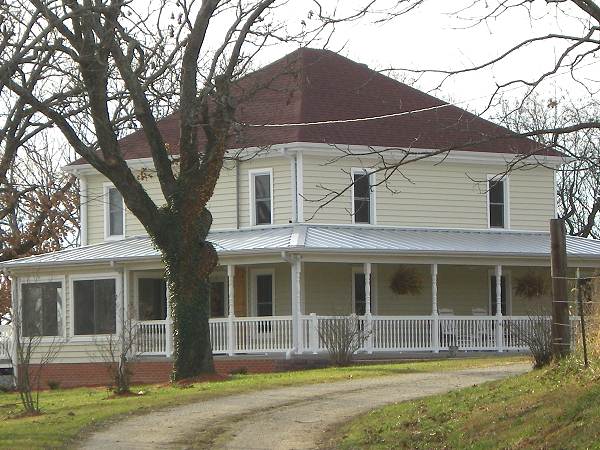
38 Hauenstein Home - 2010 Even though Ethel had the opportunity to meet many prospects among the boys at Westminster College while she attended William Woods College, both of which are in Fulton, Missouri, she chose to come home and marry a local boy to live the rest of her life on a working farm.
My wife, Judy (Steen) knew Billie and Ethel quite well since the Hauenstein farm was near her family’s farm. She remembers the couple at a time when their children no longer were home. Every Christmas the Steen family would find a “surprise” basket of candy and fruit on the doorstep Christmas morning. It didn’t take long to figure out the basket was from the Hauensteins’. These were lean years for turkey farmers then and Holmes and Elva Steen had to work long hours to provide for their six children. Holmes spent dawn to dusk on the farm and Elva worked at the shoe factory in Eldon. Not only were the Hauensteins’ kind with their giving but they took the children to church as well. Judy remembers how much she was impressed by Ethel’s demeanor and speech, being that of a refined woman of a more urban setting than a farm in Tuscumbia. Here is a photo of Ethel taken in the time frame when the Steens’ knew her (photo 39).
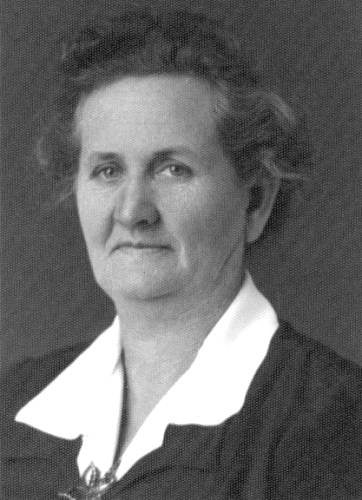
39 Ethel Moles Hauenstein, wife of William Hauenstein III The obituary of William H. “Billie” Hauenstein contains interesting historical information which may be of interest to some readers:
William H. (Billie) Hauenstein, 74, a member of one of Miller County's pioneer families, died last Thursday afternoon, December 13, (1962) at his farm home on the Osage River between Eldon and Tuscumbia. He had been critically ill since suffering a stroke on Tuesday night, Dec. 4. Mr. Hauenstein was a farmer and a retired Rock Island railroad brakeman.
He was born Sept. 1, 1888, at Tuscumbia, the son of William H. and Martha (Challis) Hauenstein. He was the third generation of his family to bear the name, William Henry Hauenstein, His grandfather, William H. Hauenstein, had come to mid-Missouri from Rhine, Bavaria in 1865. The family was among the pioneers in the business development of Tuscumbia and Miller County.
On Feb. 12, 1911, Mr. Hauenstein was married to Miss Ethel Moles in a ceremony at the home of her father, Prof. H. L. Moles, at Tuscumbia. Throughout their married life, the Hauensteins lived on the Osage River farm, which is still the family home.
In addition to his wife of the home, Mr. Hauenstein is survived by five daughters, Mrs. Corrine Bottoms of Florissant, Mrs. Olive Walton of Kansas City, Mo., Mrs. Lucille Harbison of Kansas City, Kansas. Mrs. Billie Sue Gilmore of East St. Louis, Ill. and Mrs. Phyllis Hall of Houston, Texas; three sons, Bennet L. Hauenstein of St. Paul, Minnesota, Kenneth Hauenstein of Tuscumbia, who has been working in Oregon, and Russell Hauenstein of Kansas City, Kansas; a brother, Fred Hauenstein of Kingsbury, California; a sister, Mrs. H. L. Wright, of Tuscumbia; 18 grandchildren, and seven great-grand-children.
Mr. Hauenstein was a member of the Presbyterian Church in Tuscumbia. He was with the Rock Island Railroad for twenty years.
Funeral services for Mr. Hauenstein were held at 2 p.m, Monday at the Presbyterian Church in Tuscumbia. The Rev. A. L. Alexander and the Rev. Walter C. Kennicutt officiated.
Burial was in the Tuscumbia Cemetery under the direction of Phillips Funeral Home of Eldon.
Pallbearers were A. J. Lefever, Dickie Miller, Truman Miller, Holmes Steen, Lloyd Slone, and Kern Newton
I want to acknowledge the website of Kelly Hokkanen which contains many photos of the Hauenstein and Moles families, quite a few of which were copied for this narrative of the Moles family.
Kelly is the daughter of Phyllis Hauenstein Milton who was the daughter of William “Billie” Hauenstein and Ethel Moles.
I am grateful to our website technical assistant David Statler for researching and locating the information about Lois Dean Moles Smead and her husband, Herbert Smead from the Social Security Death Index.
Recently, we were notified by Kevin Malear of Eldon that he had the original Olean telephone switchboard which he was willing to donate to the museum. He had bought the switchboard at a sale more than fifteen years ago but was running out of storage space in his home for it since it was quite large. We were very happy to receive the switchboard because we did not have anything like it in the museum. We do have a small switchboard donated to the museum by the Alf Eads family which Alf had designed for Iberia in the early 1900’s but it is not as large nor had the capacity of the later model one used in Olean. So, with the help of Quentin Wright of Iberia and his moving van we went to the Malear home last week to take possession of the switchboard. Here is a photo of it taken at the museum after it was delivered (photo 40):
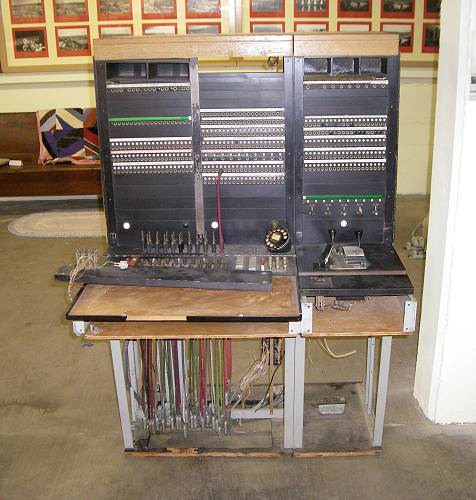
40 Olean Switchboard And here is a photo of Kevin and his father Jack Malear at their home north of Eldon (photo 41):
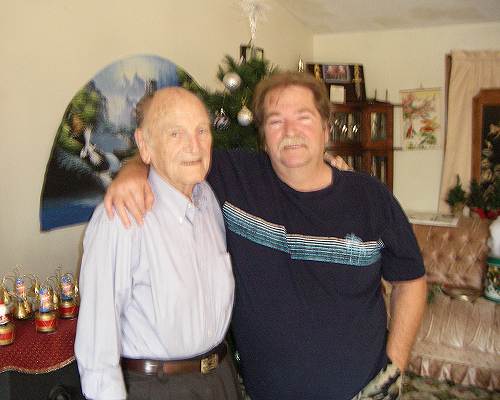
41 Jack and Kevin Malear Jack has been in the area since 1960 when he was transferred here by Union Electric Company (now AmerenUE). Kevin attended the Eldon schools. Jack said he thought the last person to be an Olean operator was a Mrs. Davis.
For more information I called Betty Roark of Olean and she told me that her grandfather, William Bartsch, was the first person to run the Olean switchboard. He had had an accident previously which caused him to be confined to a wheelchair, so he no longer could ambulate independently. However, fortunately for Mr. Bartsch, about the time of his accident in 1916 the telephone switchboard was set up in Olean and he was given the job of being the operator. Betty said that William and his wife, Lina, operated the switchboard until the late 1940’s when it was turned over to Louella Shorter. Betty said the last person to operate it was Walter Davis. She said the building where the switchboard was located isn't present now, but it originally was located across the street from the red brick house which now is still standing on the top of the hill going into Olean.
Betty has a clipping in her files about the old Olean Switchboard which has a photo of William Bartsch and his wife, Lina, her grandparents. Here is the photo (photo 41a):
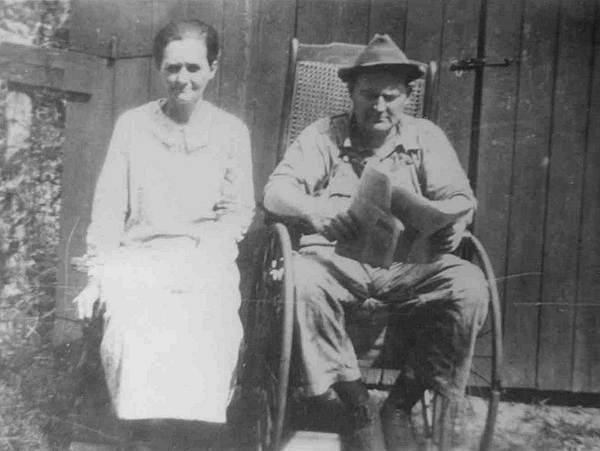
41a William and Lina Bartsch - 1928 The clipping also includes this very interesting narrative about William Bartsch, his family and the Olean Switchboard:
Early Phone Service in Olean Recalled
(unknown newspaper date: November 15, 1981; from the collection of Betty Roark)
Early days of telephone service in Olean were recalled by Edna Crum Turpin of Olean whose father, the late William (Bill) Bartsch, took care of the Olean switchboard for more than three decades, operating it from his wheelchair.
It was a family affair. Mr. Bartsch and his wife, Lina, were the operators when they began their switchboard duties, but their two daughters, now Mrs. Opal Harrison, also of Olean, and Mrs. Turpin, grew up memorizing phone numbers.
Those early days were brought to mind as this week marked the 100th birthday anniversary of the late Mr. Bartsch who was born November 15, 1881.
“He was so special, like all dads and moms are.” Mrs. Turpin said, “But he did so many things for others so many years for so very little pay.”
When he was 31 years of age, he suffered a broken back in a farm accident, falling from the top of a load of hay to concrete below. He never walked again.
“I never saw my dad walk or stand.” Mrs. Turpin said, “yet he made a living for us two kids by taking care of the Olean switchboard.”
First, in 1917, there were two switchboards…one for the farmers and one for the townspeople. The town system, she recalled, was owned by J.C. May at that time.
Mr. and Mrs. Bartsch were the operators at $20 a month. Then the two phone services consolidated and Mr. Bartsch could take care of it all.
More than 230 telephones were served by the Olean switchboard including 14 business places in town. Later, Southwestern Bell telephone Company provided service to the area.
“Dad could fix the switchboard when lightning burned the tiny wires in the back.” Mrs. Turpin recalled. “Then we kids would drive the Model T with him so he could tell us where to go to the lines that were broken or crossed so we could fix them in order for the people to ring us.”
Personal service provided through the switchboard in the Bartsch home at Olean went beyond the requirements of regular duties.
“When the calls came and people couldn’t hear or get their party who might not be home, Dad would keep right on ringing that number until he saw to it that the important messages got through day or night.
“Even now after 32 years never a day goes by but what we think and speak of our wonderful Dad, so patient: he never saw anyone he didn’t like. And my Mom waiting and caring for him all through the years. Not once did I hear of their burden too heavy.”
With increased telephone duties, their wages increased to $65 a month.
“We kids grew up memorizing everyone’s number and rings.” She said.
“I think because he lived in a wheelchair, he lived to help others more,” Mrs. Turpin said of her father.’’
In 1948, Mr. Bartsch grew ill and had to give up “his beloved switchboard and all of his friends.”
The family moved a few houses away and in 1949 he died. Mrs. Bartsch died of a heart attack in 1957.
We are very grateful to Betty Roark for supplying us this newspaper clipping which gives so much more information about the Olean Switchboard and the first family to operate it.
Our website attracts readers from many distant areas of the country. I even have received emails from overseas once in a great while. Recently, we received a letter from Charles Ganno of Hernando, Florida which was prompted by the Progress Notes of November 30, 2009 which discussed the Perkins and Law car Chevrolet dealership. You can read Mr. Ganno’s letter in this attached copy (photo 42):
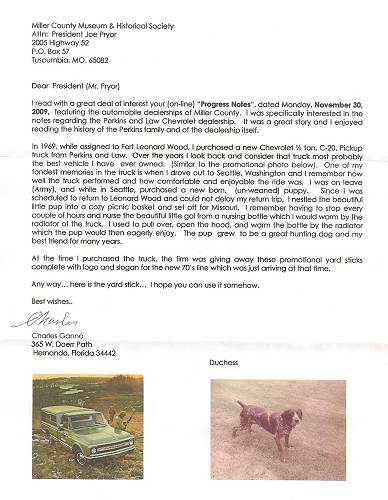
42 Letter from Mr. Ganno
Click image for larger viewHere is a photo of the yardstick ruler Mr. Ganno sent us which he mentions in his letter he received from the Perkins and Law dealership (photo 43):
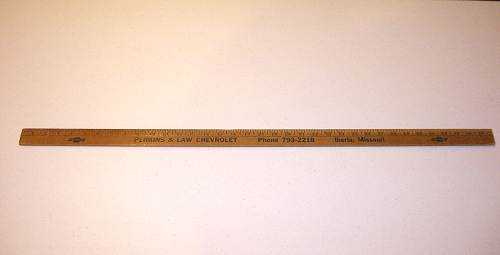
43 Perkins and Law Yardstick
Click image for larger view
Last week I discussed the story of Arthur Clark who had worked on steamboats which negotiated the Osage River in the late 1800’s and early 1900’s. He mentioned in that narrative that dikes were built in the late 1800’s to control the river depth in order to allow the steamboats access to the upper Osage River. I found a narrative which records a modern boat trip up the Osage some twenty five miles downstream from Tuscumbia which discusses some of the features of the dikes built long ago to control the depth of channels the old steamboats negotiated.
Attached here is a PDF document with photos of that narrative (photo 44):
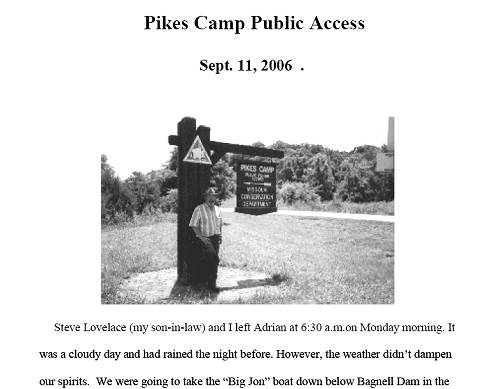
44 Pikes Peak Landing
Click image to read entire document in PDF format
That’s all for this week.
 Joe Pryor
Previous article links are in a dropdown menu at the top of all of the pages.
|

